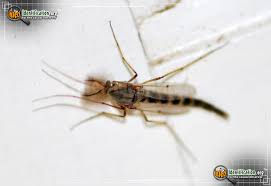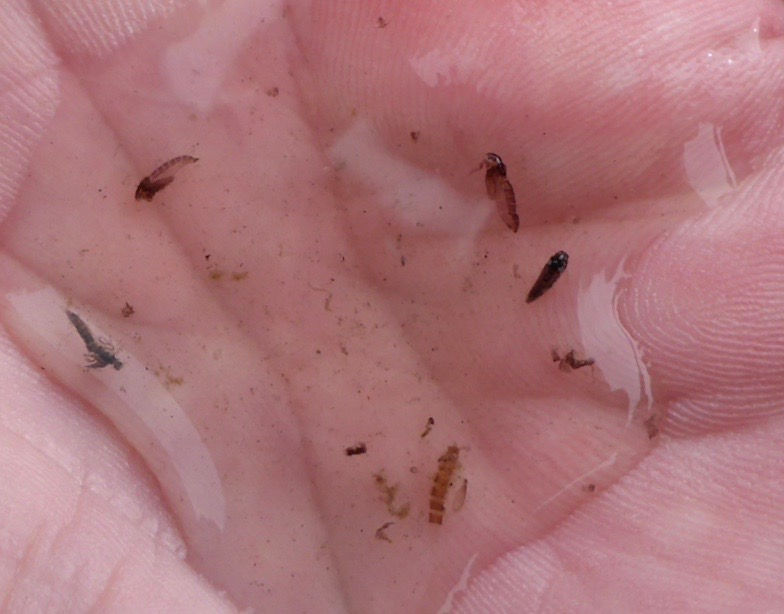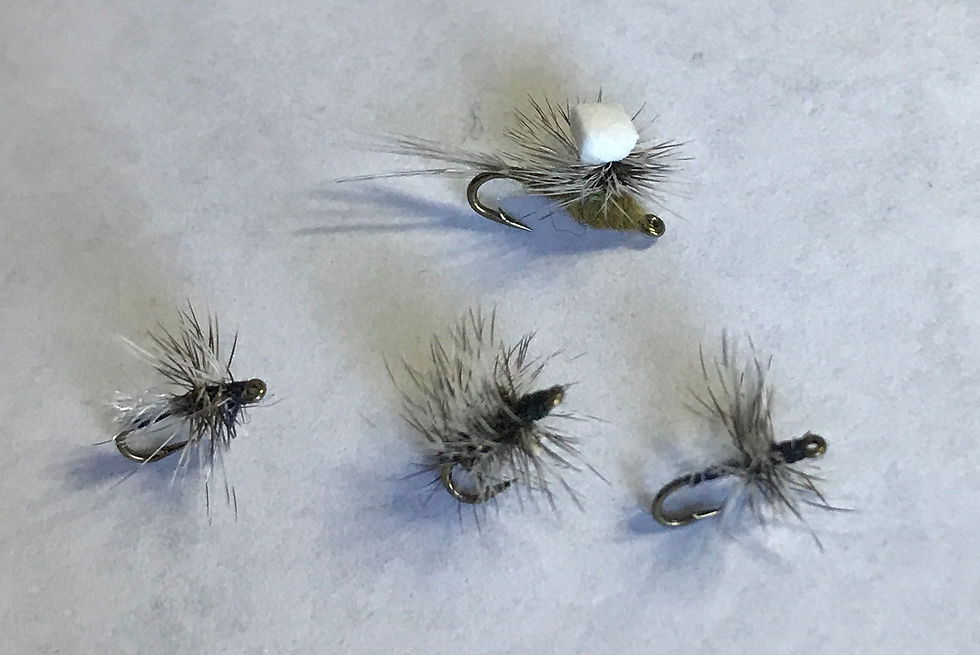February 14, 2020
Colorado had an active weather pattern this week – with snow and temperatures in the 30s. At the beginning of the week I was targeting Friday as a possibility to get in a day on the water – as the temps we’re forecasted to break out of the 30s and get near 50F for a high. But things changed for me on Monday.
As a routine, Keeny and I take a 3 mile walk every day. So on Monday, we set out at about 2p as it just started to snow – again! The sidewalks were just wet at the time - mostly just wet. We approached a spot that had bit of snow cover – and neither of us paying attention – stepped right into it and found out there was sheer ice underneath. Yep – we both went down. Luckily, Keeny landed mostly on me and only has a small bruise to show for it. I took the worst of it – and ended up with a broken bone in my wrist. Ouch!
So I’m out of action for the next 4 to 5 weeks. As of yesterday – I have a cast from my right hand to just below my elbow. I’m hoping I can still tie some flies to keep me busy – will give it an attempt later today. So my next couple of posts will focus on the flies I use and some of the techniques used to fish them.
Midges are the topic this week - here's one in an adult stage.

Midges are an order of insects (flies) called Diptera – meaning two wings. During their life cycle they go through a complete metamorphous – that being egg, larva, pupae, and adult. There are thousands of different midge species (3,500 aquatic species in North America according to Pat Dorsey, Fly Fishing Tailwaters) – and they are able to thrive in extreme conditions, from freezing cold to very warm water. So you will find midges active – going through some part of their lifecycle - throughout the year in rivers, streams, and lakes in North America. This makes them a staple imitation for fly fishermen. They do not like direct sun light and usually hatch early in the morning and at dusk. Imitations range in size from #14 to #28 – with most that I fish in the #18 to #24 sizes. The size varies by the type of midge and time of year. In the winter the midges are very small and in the spring they are large (by midge standards).
When tying flies it’s important for your imitation to have the right size, form, and color – in that order of importance. Pat Dorsey refers to the form as the “silhouette” – which is probably more descriptive of what you want. I have found that using a seine and a stomach pump (on only a few fish that are caught) – really helps both in tying flies and selecting flies to use for the day. They enable you to see real life examples of what type of flies are in the water, what they look like (their size, shape, and color) – and what the fish are eating.
Midges in pupae stage - found in a 19" Rainbow.

For reference, John Barr and Pat Dorsey are two accomplished and respected fly fishermen that I refer to for most of the fly patterns that I tie and the techniques I use to fish them – beyond that youtube is very helpful with fly tying techniques. John Barr’s Barr Flies, and Pat Dorsey’s Fly Fishing Tailwaters and Fly Fishing Guide to the South Platte River Volumes I & II, and Jim Schollmeyer’s Hatch Guide for Western Streams are excellent reference books for fly fishing techniques, insect entomology, and identifying different flies and their pattern imitations.
Except where noted, I tied all the flies in this post.
When I arrive at the river in the morning and there is no evident midge – or any other - hatch, I will start with a 3 tandem midge set-up. Maybe a size 18 Desert Storm as the lead fly, followed by a #22 Mercury Black Beauty and a #24 Mercury Miracle Midge. Alternately, I might use a #18 Red Midge Larva as the lead fly and substitute the last fly with a pupae (emerger), like a Top Secret Midge. What I’m trying to accomplish is to identify what the fish are focused and feeding on - what size, form (what part of the life cycle), and color. As John Barr commonly says in Barr Flies – “let the fish tell you what they want”.
Desert Storm (top fly). Mercury Black Beauty, Mercury Holograph Black Beauty, and Black Beauty (second row, from left). Mercury Miracle Midge and Miracle Midge (bottom row, from left).

These are all midge larva patterns - in various larva stages. Just to complicate things - there are 4 midge larva stages! Instar 1 through 4. Also, I'm experimenting with the Mercury Holograph Black Beauty. This is my creation - I've modified the body with black holograph tinsel to give it more shine. Will see how the fish like it....
Red True Larva, Red Mercury Zebra Midge, Red Zebra Midge (top row, left to right). Harvester Midge, Mercury Flashback Black Beauty, Disco Midge (2nd row, left to right). Top Secret Midge, Red Manhattan Midge, Black Rojo Midge (3rd row, left to right).

These are all imitating the larva stage, except for the 3rd row. These ones are imitating midges in the pupae stage.
In the same situation, especially if I can see fish feeding in the column and the water is very clear, I might try a Dry Dropper or a Hopper/Copper/Dropper set-up. John Barr covers these techniques in his Barr Flies book. I’ve found that they are effective techniques, especially if the fish are easily spooked, or leader or indicator shy. They also help to get the flies into the right column (or height) in the water.
For the Dry Dropper set-up - I will usually use an Amy’s Ant or a Puterbaugh Caddis as the "Dry", and a Top Secret Midge, or a Rojo Midge, or Manhattan Midge as the "Dropper" if I think a hatch is taking place. If no hatch is evident, I may drop a midge larva such as a Mercury Black Beauty, Mercury Miracle Midge, or a Mercury Blood Midge.
Amy's Ant & Puterbaugh Caddis (top row, left to right). Top Secret Midge, Black Manhattan Midge, Red Rojo Midge (2nd row, left to right). Mercury Black Beauty, Mercury Miracle Midge, Mercury Blood Midge (3rd row, left to right).

Note that I didn't tie the Amy's Ant.
For the Hopper/Copper/Dropper set-up, I’ll use the Amy’s Ant as the lead, followed by a Copper John, then either an pupae (emerger) or larva pattern. The Copper John is tied in various colors – and the color selection is dependent on what bugs are active at the time. I'll follow the Copper John with either a larva or pupae midge pattern.
2 variations of Amy's Ant (top row). Red, Copper, Chartreuse Copper Johns (2nd row, left to right)

Note that I didn't tie the Ants or the Chartreuse Copper John.
If the midges are actively hatching – I will definitely use an emerger as the last fly in my set-up. Favorites are Dorsey’s Top Secret Midge or Manhattan Midge, and Garcia’s Rojo Midge. I like to fish these on a dead drift. If I don’t get a hit on the drift – I let the flies “swing” at the end, then let them “sit” for a bit. This technique imitates an emerging midge and has been very effective for me in getting hook-ups.
If the fish are rising and feeding on midges, my go to flies are Griffiths’ Gnat, Matt’s Midge, or a Barr’s Vis-a-Dun. I usually trail one of these behind a Parachute Adams or an Amy’s Ant. Dead drift is the technique here and it's very important – as the fish will not hit your fly if there is any kind of drag evident.
Parachute BWO (top row). Vis-a-Dun, Griffith's Gnat, Matt's Midge (2nd row, left to right).

Fishing dries is the most fun for me - there is nothing as exciting as a fish taking a dry!!
댓글